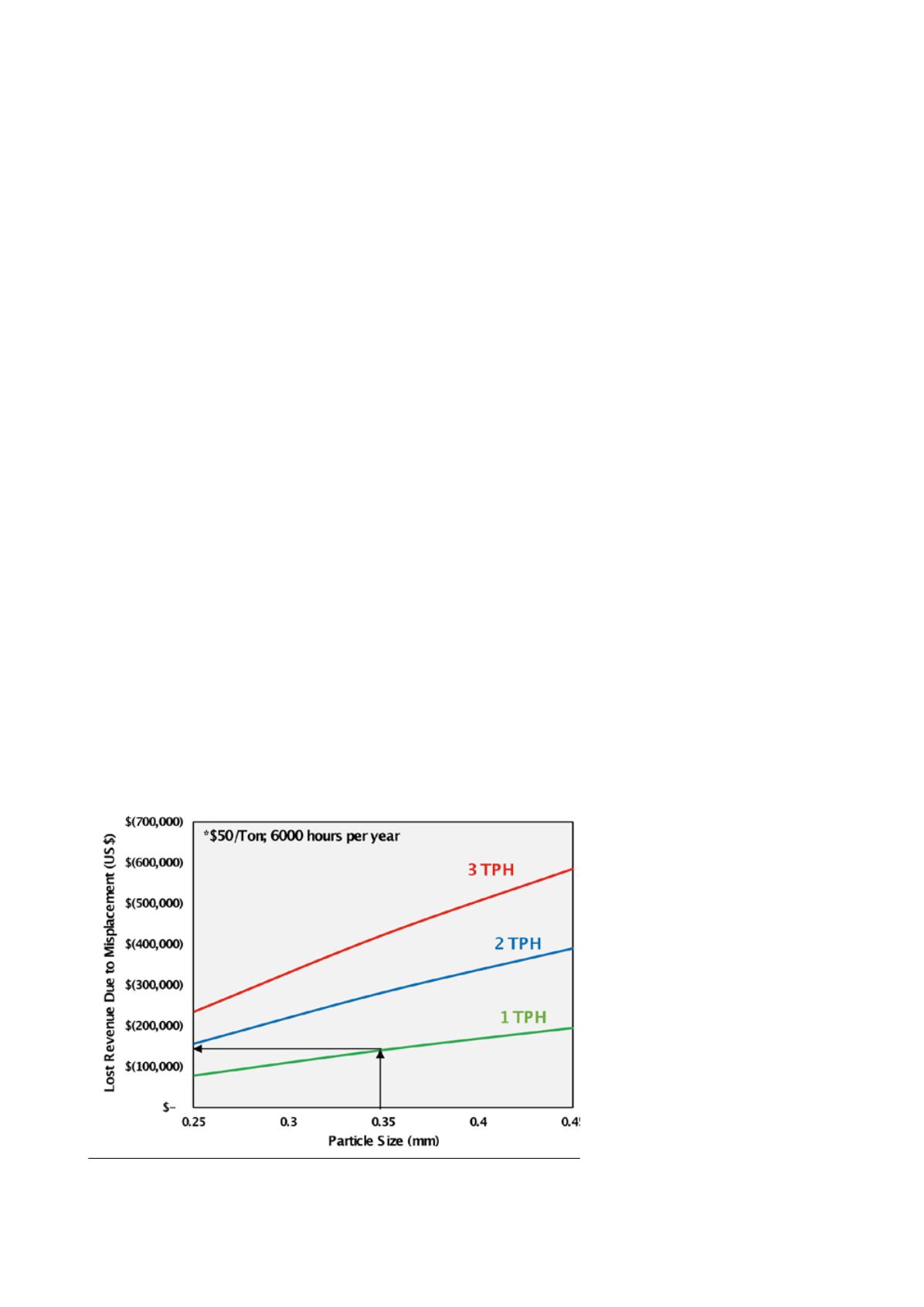
spirals or other water-based separators
for sizes 0.15 – 1 mm, and froth
flotation for sizes less than 0.15 mm.
Since the separation efficiency of coal
cleaning equipment tends to drop off
dramatically when treating misplaced
particle sizes, efficient size separation
is crucial to obtaining optimal plant
performance. For example, Figure 1 is
a simplified example that shows the
loss in revenue due to errantly placing
oversized material into a froth flotation
circuit. This material (0.25 – 0.45 mm)
is readily recovered in a spiral circuit
at relatively high recovery values
(+90%); however, flotation recoveries
for this same particle size class ranges
from 30% – 60%, depending on the
feed ash content and other factors.
This simplified example assumes a
constant coal price of US$50/short t
and 6000 operating hours per year.
Considering all of this information, the
results show that misplacing just
1 short tph of 0.35 mm particles into a
flotation circuit can lead to a net
revenue loss of nearly US$150 000/yr.
It is also important to note that this
example did not account for other
downstream effects, such as increased
reagent consumption or poor
incremental quality control that could
lead to even greater losses. Therefore,
the true cost of poor classification can
be staggering in many industrial
operations.
Cyclone utilisation
Like coal cleaning technologies, size
separation units are also only effective
for a particular range of particle sizes.
While vibrating screens and sieve
bends are used for coarse and
intermediate particle sizing,
hydrocyclones are the workhorse for
size separation below 0.5 mm. These
classifying cyclones used for primary
sizing are often 15 in. – 20 in.
(38 mm – 51 mm) in diameter, and are
designed to cut at 100 µm – 250 µm. At
these small sizes, traditional screens
blind very rapidly, and the screen area
needed to overcome this blinding
tends to be quite impractical at the
large throughputs in preparation
plants. Alternatively, cyclones can
make fine size separations at high
throughputs, while being mechanically
simple and relatively inexpensive.
In addition to primary sizing,
cyclones are also used in deslime
applications. Even where flotation is
employed for fine coal cleaning, many
of these operations note the difficulties
in processing and handling extremely
fine material (<40 µm). Material at this
size often has a high clay content and
can lead to increased flotation reagent
requirements, poor product moisture
and issues with coal handling. Given
these concerns, some operations
choose to employ a ‘deslime’ circuit,
where 6 in. (15 mm) dia. cyclones are
used to remove the material less than
40 µm from the flotation feed. This
material is combined with the other
fine reject and discarded to fine waste
disposal units.
Cyclone operating
principles
Considering both primary sizing and
deslime applications, it is apparent
that cyclone usage is ubiquitous in any
modern preparation plant. As the prior
analysis also demonstrates, efficient
design and operation of cyclones is
crucial in optimising plant
performance.
In analysing and assessing cyclone
performance, one must first consider
that classifying cyclones are not like
screens. Screens have a defined and
constant opening size that prevents all
coarse material from passing through
to undersize (unless the screen has a
wear hole). Finer material then has the
opportunity to pass, and the
probability of passing is dictated by
the available screen area, the particle
shape, the bed depth and other factors.
However, with enough screening time,
all fine particles will pass to the
undersize.
Classifying cyclones have no such
limitation. Instead, cyclones rely on the
differences in particle settling
velocities in water. To illustrate this
principle, consider a bottle that has
been filled with slurry. If that mixture
is first agitated and then allowed to
settle, one will observe the larger,
heavier particles settling first,
followed by the finer, lighter particles.
One could then easily separate the
fines from the coarse by simply
pouring off the mixture while the fines
are still suspended. Unfortunately, a
perfect separation is not possible, since
some of the fine material that started
near the bottom of the bottle will settle
before the coarse particles that started
near the top. As a result, there will
always be some contamination of fine
material in the coarse product.
Hydrocyclones operate under the
same principle, except the addition of
a centrifugal force accelerates the
settling speed. Slurry is pumped
under pressure into cylindrical body.
The fluid enters the cylinder
Figure 1. Lost revenue due to misplacement of oversized material into a flotation
circuit.
22
|
World Coal
|
June 2016


